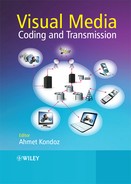11.1 Introduction
Future media Internet will allow new applications to be realized with support for ubiquitous media-rich content service technologies. Virtual collaboration, extended home platforms, augmented, mixed and virtual realities, gaming, telemedicine, e-learning, and so on, in which users with possibly diverse geographical locations, terminal types, connectivity, usage environments and preferences will access and exchange pervasive yet protected and trusted content, are only a few of the possibilities. These multiple forms of diversity require content to be transported and rendered in different forms, which requires the use of context-aware content adaptation. This avoids the alternative of predicting, generating, and storing all the different forms required for every item of content. Figure 11.1 provides a generic representation of entities and contextual descriptions that are engaged in the delivery of context-aware multimedia applications.
For the aforementioned reasons, there is a growing need to devise adequate concepts and functionalities for a context-aware content adaptation platform that suits the requirements of such multimedia application scenarios. This platform needs to be able to consume low-level contextual information to infer higher-level contexts, and thus decide the need for and type of adaptation operations to be performed upon the content. In this way, usage constraints can be met while restrictions imposed by digital rights management (DRM) governing the use of protected content are satisfied.
This chapter is dedicated to providing comprehensive discussions on the use of contextual information in adaptation decision operations, with a view to managing DRM and authorization for adaptation, and consequently outlining appropriate adaptation decision techniques and adaptation mechanisms. The main challenges are realized from identifying integrated tools and systems that support adaptive, context-aware, and distributed applications that react to the characteristics and conditions of the usage environment and provide transparent access and delivery of content, where digital rights are adequately managed.
Figure 11.1 Generic scenario illustrating the entities of a context-aware service. Reproduced by Permission of ©2008 IEEE
To meet these challenges, the discussions in this chapter focus on describing a scalable platform for context-aware and DRM-enabled adaptation of multimedia content. The platform has a modular architecture to ensure scalability, and well-defined interfaces based on open standards for interoperability as well as portability. The modules are classified into four categories, namely: (1) adaptation decision engine (ADE); (2) adaptation authorizer (AA); (3) context providers (CxPs); and (4) adaptation engine stacks (AESs), comprising adaptation engines (AEs) within. The platform makes use of ontologies during the adaptation decision-taking stage in order to enable semantic description of real-world situations. The decision-taking process is triggered by low-level contextual information and driven by rules provided by the ontologies. It supports a variety of adaptations, which can be dynamically configured. The overall objective of this platform is to enable the efficient gathering and use of context information, in order to ultimately build content adaptation applications that maximize user satisfaction.
This chapter is structured as follows: Section 11.2 presents an overview of the state of the art in context-aware content adaptation, focusing on context-aware applications, systems, and existing standards in the area. Section 11.3 details the perspective adopted in this chapter for generating and aggregating contextual information from diverse sources and profiling for generic multimedia communication and/or content access/distribution scenarios. Section 11.4 describes a selected application scenario for context-based adaptation of governed media content, identifying the scenario-based requirements in terms of contextual information. Section 11.5 presents the mechanisms that process the contextual information in order to take decisions regarding possible reactive measures, and also discusses the use of ontologies in context-aware content adaptation, particularly in the adaptation decision process. These reactive measures request an appropriate adaptation of content to suit the conditions and constraints imposed by the context of usage in the specified application scenario. This section presents the DRM-based adaptation and authorization for an adaptation operation, while also providing a description of the use of the adaptation mechanism in the sequence of the decision process. It also describes user-centric content adaptation tools, which can be exploited as a form of AE to process the decision taken by the ADE with assistance from the DRM and authorization modules. Section 11.6 describes the interfaces required between the different modules of the content adaptation platform and the sequence of events that take place while performing DRM-based adaptation for a particular user or group of users in specific situations. Finally, Section 11.7 draws conclusions.

